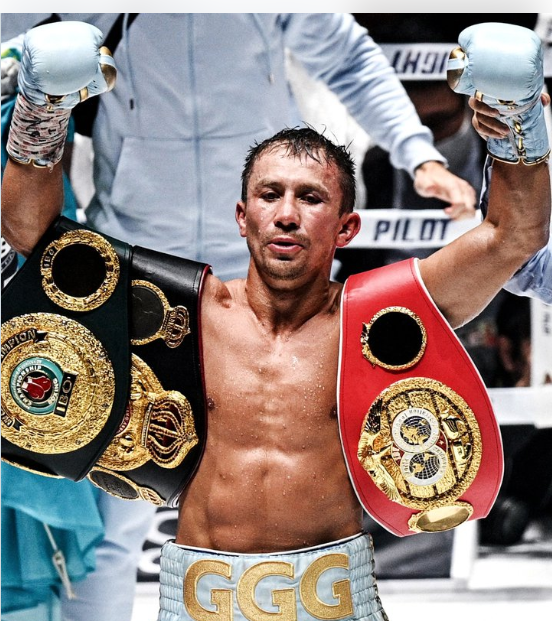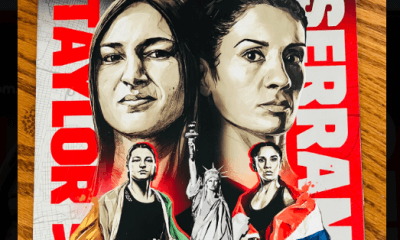Featured Articles
GGG turned 40 in Japan Which Wasn’t His Land of the Setting Sun

GGG turned 40 in Japan Which Wasn’t His Land of the Setting Sun
It is axiomatic in boxing that the last positive attribute an aging fighter loses is power, if indeed he is fortunate enough to ever have had much of it in the first place. George Foreman, who ascended to the heavyweight championship of the world a second time — at the unlikely age of 45 — with his 10th-round knockout of Michael Moorer on Nov. 5, 1994, is perhaps the foremost example of that hoary truism. Big George was and is adamant in his belief that big hitters such as he steadfastly hang onto that gift when other parts of their repertoire have grudgingly surrendered to the relentless march of time.
“I think it’s just something you’re born with, I really do,” Foreman once said of himself and fellow knockout artists who are dangerous even in the late stages of fights they are clearly losing on points, as he was against Moorer. “If you have it, a trainer can develop it and exploit it. The worst thing in the world is to have it and not have a trainer to explain to you what you have.”
One of Foreman’s more memorable utterances when he began his comeback after a 10-year absence from the ring wars was that “40 isn’t necessarily a death sentence” for a fighter, and especially so if he packs enough pop in his punch. And it must be true, if birthday boy Gennadiy “GGG” Golovkin, who turned the big Four-0 on Friday, the day before he was to swap punches with Ryota Murata in their middleweight unification showdown in Saitama, Japan, is still a prime example of what can happen when someone with superior firepower begins finding his target with percussive regularity.
Golovkin looked, if not exactly well past his prime, to be at least somewhat vulnerable through the first four or five rounds against Japan’s hugely popular Murata in the fight that was seen in the United States through the streaming service DAZN. Murata, a 5-1 underdog who came in as the WBA 160-pound titlist, got the better of his share of exchanges as Golovkin, the IBF champ from Kazakhstan, struggled to establish some sort of familiar rhythm. Perhaps visions of boxing’s most stunning upset, when Buster Douglas knocked out the seemingly invincible Mike Tyson on Feb. 11, 1990, in Tokyo, had even begun to float about the Saitama Super Arena, a possibility GGG had alluded to in the lead-up to the bout.
“Japan is the land of surprises, at least when it comes to boxing,” he noted. “I remember what happened in the Tyson-Douglas fight. It has been in the back of my mind throughout training camp. I already had a lot of respect for Ryota Murata, but Tyson-Douglas is a reminder to never give less than 110% every day in training camp.”
But on this Friday night – well, actually it was early Saturday morning in the U.S., due to the 11-hour time difference between EDT and Saitama – Murata (16-3, 13 KOs) was not able to continue to channel his inner Buster, nor was Golovkin (42-1-1, 37 KOs) anywhere near-ready to be taken down in the manner that Tyson had been starched in his second visit to the Land of the Rising Sun. The starkly apparent turning point came in the sixth round, when Golovkin connected with a looping right hand to the jaw, which had the effect of sending Murata’s mouthpiece sailing through the air as if it had been cleared for takeoff.
What followed thereafter, interspersed with Murata’s increasingly futile bids to re-gather momentum, were glimpses of the Golovkin who not so very long ago strung together 23 consecutive victories inside the distance, 18 of which came in world title bouts. Most of those fights ended with his opponents twitching on the canvas as if they had just been slammed into by a speeding tractor-trailer.
For those who like to dabble in numbers, CompuBox punch statistics revealed that Golovkin had connected on 257 of 629 overall, 40.9%, to 144 of 592 (24.3%) for Murata. More tellingly, as is usually the case for GGG bouts, the master blaster nailed his opponent with 150 of 321 power shots, an impressive 46.7%, to 122 of 359 (34.0%) for the well-battered Murata, whose corner threw in the towel after their guy went down and in clear distress in round nine.
Former WBO junior welterweight champion Chris Algieri, commenting for DAZN, said the Golovkin seen after Murata’s mouthpiece had gone airborne “looked like the Golovkin of old, not an old Golovkin.” And if that description isn’t entirely accurate, it was close enough against a very good fighter if not one up to the exalted standards of Canelo Alvarez, widely recognized as the planet’s top pound-for-pound practitioner of the pugilistic arts. Alvarez, against whom GGG is 0-1-1 (more than a few knowledgeable observers believed GGG deserved the nod in their first fight, which ended in a draw), is tentatively set to face him for a third time later this year, provided the Mexican superstar (57-1-2, 39 KOs) successfully gets past his May 7 date with WBA light heavyweight ruler Dmitry Bivol (19-0, 11 KOs).
It says much about Golovkin’s fearsome reputation as a lights-out puncher that Jim Lampley, the veteran blow-by-blow commentator for HBO when that premium-cable outlet was doing boxing, cites GGG as the most impressively indelible power source that he witnessed while calling fights, even more so than Foreman, Tyson, Wladimir Klitschko, Tommy Hearns, Julian Jackson or anyone else.
“Gennadiy Golovkin was the most consistently hard puncher, and it’s almost a cliché that you’re going to choose somebody from the heavyweight division, but I think it’s more interesting when somebody has consistent punching power over the course of a long career in a weight class the way Gennadiy did,” Lampley told writer Joseph Santoliquito for a story in which he lists the top performers he has covered from ringside. (Lampley says the fighter atop his overall list is Sugar Ray Leonard, with Pernell Whitaker having the best defense and Bernard Hopkins the most underrated.) “The fact he weighed in hundreds of times as an amateur and a professional at the same weight, 160 pounds, makes the retention of his punching power exciting, not to mention some of the cartoon-style knockouts he produced.”
Is Golovkin, at 40, a lesser version of himself than the middleweight wrecking machine of our memories? Maybe, at least a little. Father Time remains the one opponent no fighter can duck and dodge forever, and the calendar surely must win some rounds against those who are obliged to stay on the shelf for longer periods than they might prefer. COVID-19 is a thief that has stolen bits and pieces of fighters young and old since 2020, and the pandemic was responsible for two postponements of Golovkin-Murata until fight night finally arrived. It is reasonable to assume that GGG, who has had only two bouts since his closer-than-expected points nod over Sergiy Derevyanchenko on Oct. 5, 2019, stepped inside the ropes with a thin coating of ring rust, and Murata figured to be even more off his peak form, not having fought at all in 2020 or 2021 while waiting for the global health crisis to abate.
Unless another of those pesky variants of the virus that lingers like an unwelcome house guest suddenly appears, Alvarez-Golovkin III is likely to happen before the end of 2022, the year that boxing has gloriously stepped back into the spotlight. Even if GGG’s total skill set needs a bit more polishing in the months ahead, fight fans are secure in the knowledge that he still has enough of that great equalizer, dynamite fists, to continue to be the kind of attraction that should not be missed.
Bernard Fernandez, named to the International Boxing Hall of Fame in the Observer category with the Class of 2020, was the recipient of numerous awards for writing excellence during his 28-year career as a sports writer for the Philadelphia Daily News. Fernandez’s first book, “Championship Rounds,” a compendium of previously published material, was released in May of last year. The sequel, “Championship Rounds, Round 2,” with a foreword by Jim Lampley, is currently out. The anthology can be ordered through Amazon.com and other book-selling websites and outlets.
To comment on this story in the Fight Forum CLICK HERE
-

 Featured Articles4 weeks ago
Featured Articles4 weeks agoAvila Perspective, Chap. 330: Matchroom in New York plus the Latest on Canelo-Crawford
-

 Featured Articles3 weeks ago
Featured Articles3 weeks agoVito Mielnicki Jr Whitewashes Kamil Gardzielik Before the Home Folks in Newark
-

 Featured Articles24 hours ago
Featured Articles24 hours agoResults and Recaps from New York Where Taylor Edged Serrano Once Again
-

 Featured Articles4 weeks ago
Featured Articles4 weeks agoCatching Up with Clay Moyle Who Talks About His Massive Collection of Boxing Books
-

 Featured Articles5 days ago
Featured Articles5 days agoFrom a Sympathetic Figure to a Pariah: The Travails of Julio Cesar Chavez Jr
-

 Featured Articles3 weeks ago
Featured Articles3 weeks agoMore Medals for Hawaii’s Patricio Family at the USA Boxing Summer Festival
-

 Featured Articles1 week ago
Featured Articles1 week agoCatterall vs Eubank Ends Prematurely; Catterall Wins a Technical Decision
-

 Featured Articles4 weeks ago
Featured Articles4 weeks agoRichardson Hitchins Batters and Stops George Kambosos at Madison Square Garden





















